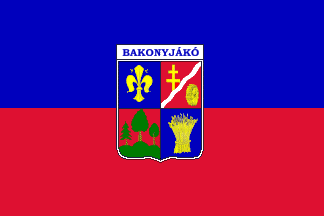 zachary harden
zachary harden
Keywords: hungary | veszprem | bakonjako | papa | jaka |
Links: FOTW homepage | search | disclaimer and copyright | write us | mirrors

Last modified: 2023-06-03 by  zachary harden
zachary harden
Keywords: hungary | veszprem | bakonjako | papa | jaka |
Links: FOTW homepage |
search |
disclaimer and copyright |
write us |
mirrors

image by Istvan Molnar, 16 May 2001
See also:
Bakonyjákó (in German Jaka) is a village in Veszprém County
in Hungary near to Town of Pápa (13
km south) in a beautiful basin of the northern hills of the
Bakony Mountains. The village has got 697 inhabitants (1990
census), nearly all of them are Hungarian. One of the Official
Ethnic Minorities of Hungary has got ethnic council in the
village: Germans. Neighbouring settlements are: Döbrönte (Dewrenten), Ganna, Farkasgyepü
(Wirtshäusl), Németbánya (Deutschütten),
Szentgál, Bakonybél,
Ugod, Homokbödöge
and Nagytevel (Deutschtewel) villages
and Pápa town.
The first mention of the settlement is from 1351, all settlers of
the village were serves of the Castle of Döbrönte. At the
time of the Turkish wars the settlement was devastated in 1543.
Jákó was resettled with Germans in 1751 by the Vajda Family,
the landlord of the village. In 1910 Bakonyjákó was a village
in the Pápa district of Veszprém County. Number of its
inhabitants in 1910: 1.833; 1.515 (82,7%)
German, 316 (17,2%) Hungarian and 2 (0,1%) other by
mother tongue, 1.780 (97,1%) Roman Catholic, 32 (1,7%) Jew,
13 (0,7%) Lutheran and 8 (0,4%) other by religion. After the
WWII most of the Germans were deported to Germany and Hungarians
deported from Czechoslovakia settled to the village. In 1982 the
territory of the destroyed Iharkút village was united with
Bakonyjákó.
Symbols of the Coat of Arms: The "Anjou lily" relates
to the 14th century, when Jákó as a tenure of the Himfy family
became an important settlement (the 14th century was the century
of the Anjou kings - King Charles I. and King Louis I the Great).
The gold sheaf of wheat relates to the agriculture, to the hard
work, to the diligence, to the persisting in insistance to the
land. The three green hills relate to the Bakony Mountains
(before 1908 the name of the village was only Jákó, from 1908
it is Bakonyjákó). The three different trees relate to the
nature, the forest and the ethnic composition of the village
(Hungarians, Germans etc..). The gold double cross relates to the
Hungarian Nation and the Christianity. The wavy silver stripe
relates to the brooks of the Bakony. The gold Mill Wheel relates
to the formerly six water-mills of the settlement. The designer
of the CoA and the flag is Mr. Zsolt Mezei.
Istvan Molnar, 16 May 2001

image by Istvan Molnar, 16 May 2001
ve-bj.gif)
image by Istvan Molnar, 16 May 2001